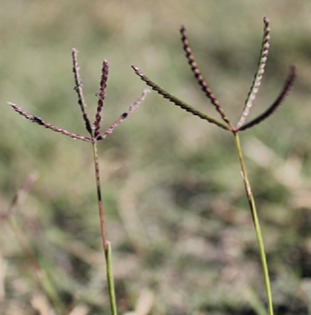Bermuda grass (Cynodon dactylon) is not just admired for its lush green carpet but also for the intricate world of seed heads it produces. Understanding Bermuda grass seed heads is key to maintaining a healthy lawn. In this article, we'll delve into the nuances of Bermuda grass seed heads and how they contribute to the overall well-being of your lawn.
Identification of Bermuda Grass Seed Heads:
Bermuda grass seed heads are one of the reproductive structures that emerge from the grass blades at specific times of the growing season. They typically appear as slender spikes in a chicken foot type pattern. On close inspection tiny seed structures are visible, giving the grass a distinctive look. Identifying these seed heads is crucial for proper lawn care.
Significance of Seed Heads:
While some may view seed heads as an aesthetic concern, they can play a vital role in the life cycle of non-hybrid Bermuda grass varieties. The appearance of seed heads indicates that the grass is entering its reproductive phase. This natural process while not necessarily essential for the survival and perpetuation of common Bermuda grass species however. More commonly pros use bermudagrass seed head production as an indicator of turfgrass health.

Important Note: Bermuda grass reproduction is most common through the production of above and below ground runners. These structures are called Stolons (above ground) and rhizomes (below ground). Stolons and rhizomes are capable of rooting in soil and creating new plants as they grow out from the original plant. They can also grow when they are cut and left on moist soil. Although bermudagrass can spread by seed, its most efficient reproduction method is through these structures.
Timing of Seed Head Emergence:
Bermuda grass seed heads typically emerge during the warmer months, especially in late spring and early summer. The timing may vary based on factors such as temperature, sunlight, and overall growing conditions. Observing the timing of seed head emergence can provide insights into the health and vitality of your lawn.
Presentation of seed heads in Bermuda grass can be an indicator of stress. Stressors can vary, but most commonly are related to water scarcity in the root zone, soil compaction, soil temperatures, and poor maintenance practices. If your Bermuda is presenting seed heads, its time to look at the lawn holistically to see what issues are present, what can be addressed, and what must be accepted.
Mowing Practices:
Proper mowing practices play a role in managing Bermuda grass seed heads. Regular mowing helps control the height of the grass and reduces the prominence of seed heads. However, it's important not to mow too short, as this can stress the grass and impact its overall health.
When you forego mowing, and your grass grows to excessively high levels and goes to seed, you're doing more harm than good. Much of the grass seed that pops up on the tips of the blade may actually be sterile-so don't expect bare patches to miraculously fill in.
Seed Head Control Techniques:
For those who prefer a seed head-free lawn, there are strategies to manage Bermuda grass seed heads. One approach is to mow more frequently during the seed head emergence period, preventing them from reaching full maturity and returning the seeds head to the soil for decomposition. Another option is to use growth regulators to suppress seed head development while promoting healthy turf.
Fertilization and Watering Impact:
The nutritional health of Bermuda grass can influence seed head production. Balanced fertilization and proper watering practices contribute to a well-nourished lawn, potentially reducing the intensity of seed head development. Consistent moisture and a nutrient-rich soil support overall grass health.
Understanding Dormancy:
In certain conditions, Bermuda grass may go dormant, leading to a reduction in seed head production. Understanding the factors that trigger dormancy, such as extreme temperatures or water scarcity, can help homeowners manage seed head concerns during specific periods.
Bermuda grass seed heads are a natural part of the grass's life cycle, signaling its reproductive phase. Regular mowing, proper nutrient management, and healthy soils will help homeowners manage Bermudagrass seed heads. By understanding the significance of seed heads and monitoring their production, you can cultivate a thriving Bermuda grass lawn that balances both aesthetics and vitality.






Comentarios